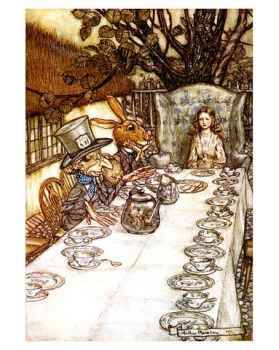We got to the parade route early, chose our spot, and set up our chairs. Having 30 minutes before the parade started, we decided to check out the action at the park, where local organizations were setting up booths. One of them was a local Civic Improvement Association. They had been successful in keeping a luxury hotel and "executive homes" from being built in an area where there was a woeful lack of infrastructure (like roads to get them in and out of the development). Now it seems their target is to prevent Wal-Mart from building in a different subdivision.
The usual litany of complaints against Wal-Mart was posted. What I found more interesting was the list of stores this group would rather see instead.
"Nordstrom's?" I asked.
"Well, we can dream," the gentleman behind the booth replied.
I nodded and kept reading. There were stores like Williams-Sonoma, Pottery Barn, Talbots, Gap, Banana Republic, Old Navy, Borders.
"We had an Old Navy not too far from here," I pointed out. "It closed due to lack of business. Do you really think the community will support these stores?" I didn't point out that the local mall already had Gap, Limited, Limited Too, and The Disney Store. While my family drove the three miles from our city to this one, I have noticed over the years that these residents won't drive outside of their city limits unless they absolutely have to.
"There are million dollar homes going up here," he pointed out.
"I know the homes on the old refinery are going for $800,000," I remarked.
"My home was recently appraised for $1.8 million," he answered.
One point eight million dollars for a home built on the site of an old oil refinery. It boggles my mind.
"And we don't have a downtown," he added. "When I moved here I was surprised that a city this size doesn't have one." He talked about how other cities in area had recently refurbished their downtowns. He talked about having events there--music events and cultural events--while you strolled through the plazas or sat at a sidewalk cafe and ate.
"Yeah, but were the people buying anything?" I asked.
We talked for a bit more. I told him I'd like to see another movie theater, maybe one that kept quality movies around for more than a week. Or more "mom-and-pop" stores rather than big chains. Then I joined my family and we watched the parade.
Later on it hit me: keeping out Wal-Mart was about more than just Wal-Mart's business practices and effect on the community. This was about image. The gentleman and his friends do not want the type of people who shop at Wal-Mart in their million-dollar neighborhood. (I know--I can be slow sometimes!) In fact, they had taken a picture of an ugly Wal-Mart store and superimposed it towering over the homes in the neighborhood so that Wal-Mart dominated the landscape. I had pointed out that the area where Wal-Mart wanted to build was where Albertson's (a local grocery chain) had originally planned on rebuilding their store.
"Albertson's pulled out," he replied, shrugging.
"Because they moved into the site where their competitor had pulled out," I said. If this area can't support two grocery stores--one a moderately upscale one at that--how will it support a Saks Fifth Avenue? (Another one of their "dream" stores.)
This area of the county was one of the last remaining in the Bay Area proper where blue-collar folks could afford to buy a home. Our neighbors are local schoolteachers, police officers, fire fighters, cable guys. Those of us who are white-collar workers commute to areas where we can't afford to buy. What kept the prices low was the heavy industry located in the area: the three refineries, the chemical plant, the railroad, the sugar plant. Many of our friends grew up here. We are Target and K-Mart people who might shop Nordstrom's for a special occasion outfit, especially during their half-yearly sale. Million dollar homes are a recent phenomenon. The older areas of the city haven't quite caught up to that and there are areas in the neighboring towns that who consider Target an upscale store.
These new homes, 2500+ square feet, three car garage, and built practically to the lot line (no yards), replace the Little League complex painstakingly built over the seasons by dedicated volunteers. Volunteers whose sons and daughters played T-ball, baseball, and softball; whose kids rode on the backs of the flatbed trucks during the parade; who wore jeans from Penney's and Sears, not Nordstrom's. Volunteers who worked in the concession booth, covered with sno-cone syrup and splattered with ketchup and mustard. Volunteers who still come out to the parade to hang out with their friends and neighbors in lawn chairs and call out the names of those they know. Their city is being gentrified. I wonder if they realize it?
Wednesday, July 06, 2005
Keeping Out The Riff Raff
Posted by
March Hare
at
5:42 AM
![]()
Subscribe to:
Comment Feed (RSS)




|